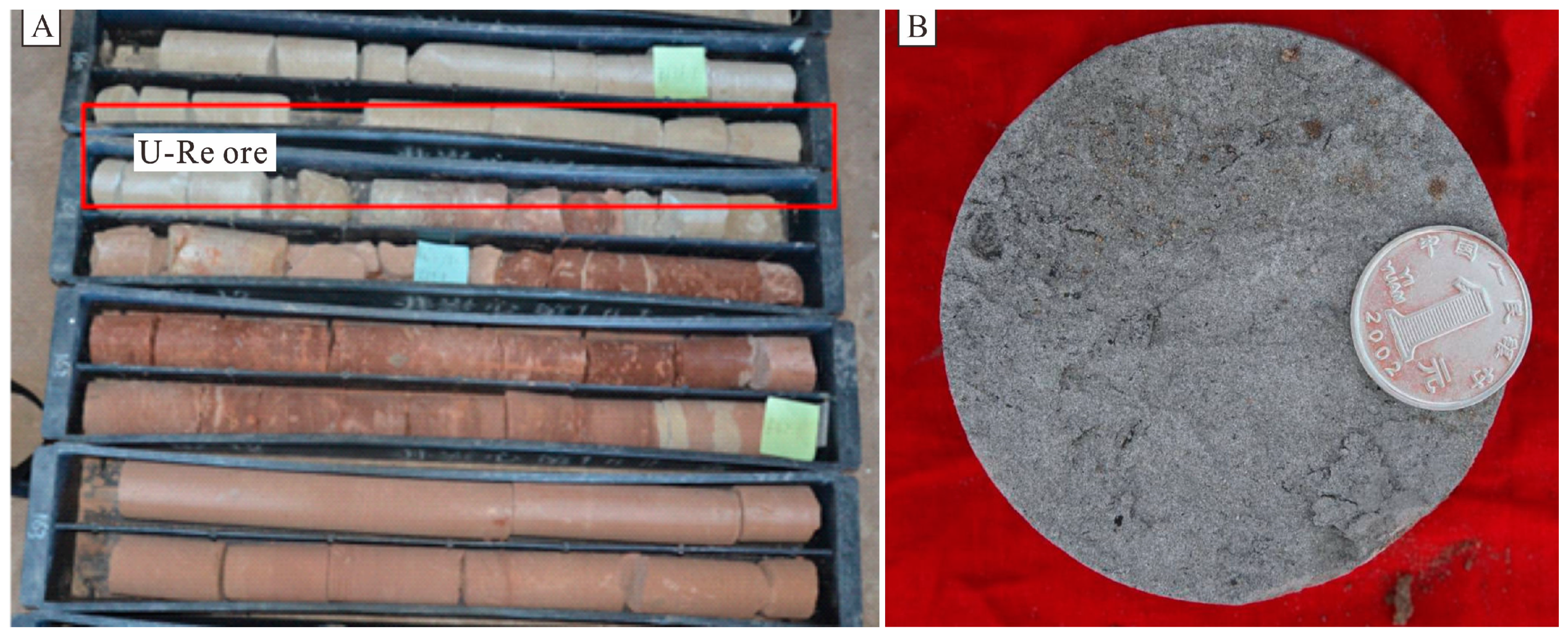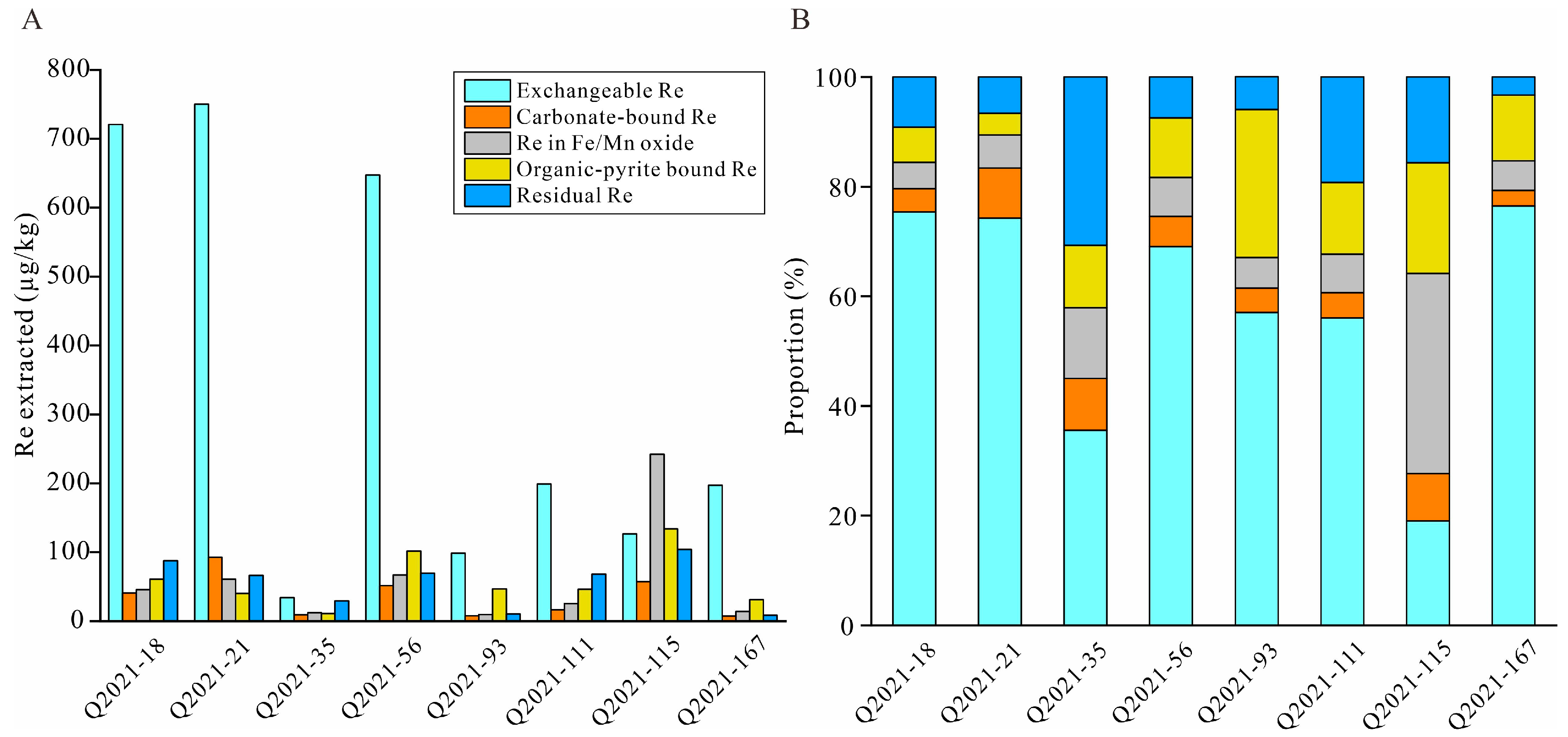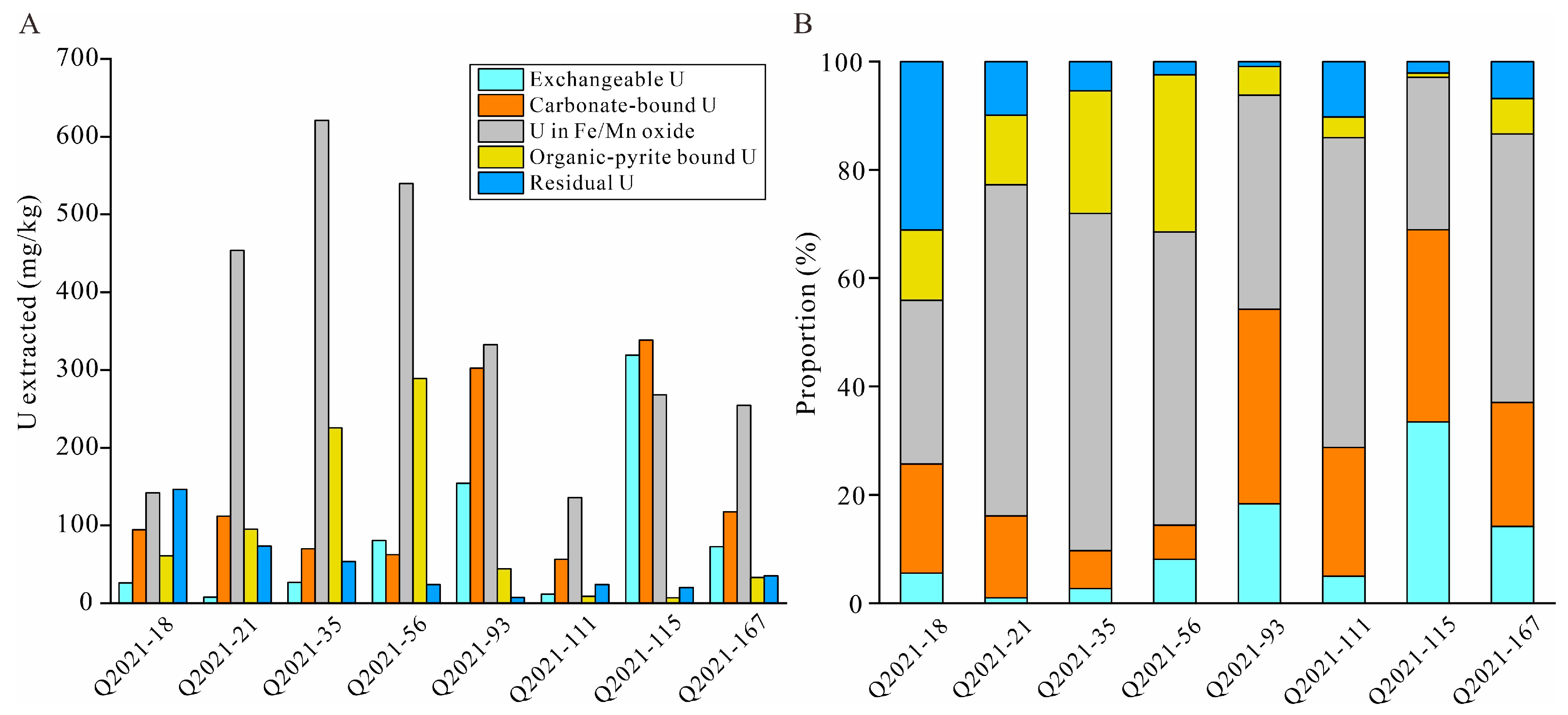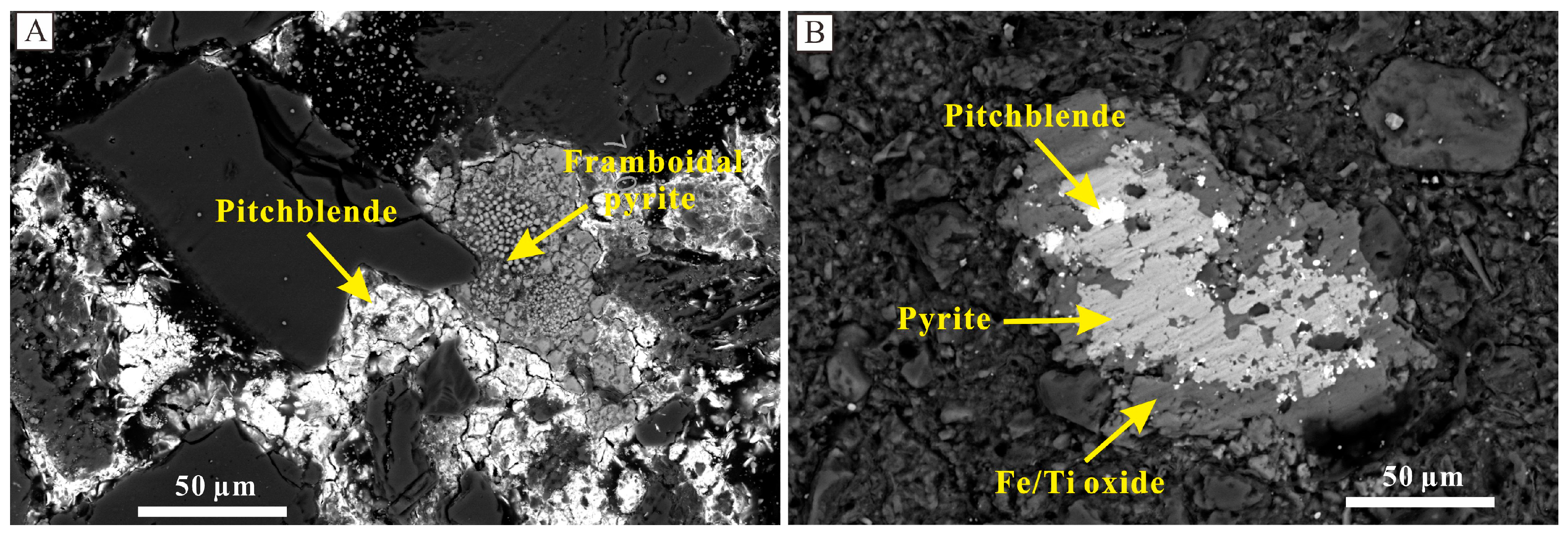Occurrence State and Enrichment Mechanism of Rhenium in the Qianjiadian Uranium Deposit in the Southwestern Songliao Basin, Northeast China
Abstract
1. Introduction
2. Geological Setting
2.1. Songliao Basin
2.2. Qianjiadian Uranium Deposit
3. Materials and Methods
4. Results
4.1. Results of Chemical Sequential Extraction
4.1.1. Sequential Extraction of Rhenium
4.1.2. Sequential Extraction of Uranium
4.2. Mineralogical Characteristics
4.2.1. Image Analysis
4.2.2. EMPA of Uranium Minerals
4.2.3. Characteristics of Clay Minerals
5. Discussion
5.1. Occurrence of Rhenium in the Qianjiadian Uranium Deposit
5.2. Enrichment of Rhenium and Implications for In-Situ Leaching
6. Conclusions
Author Contributions
Funding
Data Availability Statement
Conflicts of Interest
References
- Taylor, S.R.; Mclennan, S.M. The Geochemical the Continental Evolution Crust. Rev. Mineral. Geochem. 1995, 33, 241–265. [Google Scholar] [CrossRef]
- Rudnick, R.L.; Gao, S. Composition of the Continental Crust. In Treatise on Geochemistry; Holland, H.D., Turekian, K.K., Eds.; Elsevier-Pergamon: Oxford, UK, 2003; Volume 3, pp. 1–64. [Google Scholar]
- John, D.A.; Seal, R.R., II; Polyak, D.E. Rhenium. In Critical Mineral Resources of the United States—Economic and Environmental Geology and Prospects for Future Supply; Schulz, K.J., DeYoung, J.H., Seal, R.R., II, Bradley, D.C., Eds.; U.S. Geological Survey Professional Paper 1802: Reston, VA, USA, 2017; pp. 1–49. [Google Scholar] [CrossRef]
- Werner, T.T.; Mudd, G.M.; Jowitt, S.M.; Huston, D. Rhenium mineral resources: A global assessment. Resour. Policy 2023, 82, 103441. [Google Scholar] [CrossRef]
- Brenan, J.M. Rhenium. In Encyclopedia of Geochemistry: A Comprehensive Reference Source on the Chemistry of the Earth; White, W.M., Ed.; Springer International Publishing: Cham, Switzerland, 2018; pp. 1312–1314. [Google Scholar]
- Kojonen, K.K.; Roberts, A.C.; Isomaki, O.-P.; Knauf, V.V.; Johanson, B.; Pakkanen, L. Tarkianite, (Cu,Fe) (Re,Mo)4S8, a new mineral species from the Hitura Mine, Nivala, Finland. Can. Miner. 2004, 42, 539–544. [Google Scholar] [CrossRef]
- Hitzman, M.; Kirkham, R.; Broughton, D.; Thorson, J.; Selley, D. The sediment-hosted stratiform copper ore system. In Economic Geology One Hundredth Anniversary Volume 1905–2005; Hedenquist, J.W., Thompson, J.F.H., Goldfarb, R.J., Richards, J.P., Eds.; Society of Economic Geologists, Inc.: Littleton, CO, USA, 2005; pp. 609–642. [Google Scholar] [CrossRef]
- Dahlkamp, F.J. (Ed.) Uranium Deposits of the World; Springer: Berlin/Heidelberg, Germany, 2009; pp. 1–493. [Google Scholar]
- Song, Y.; Ren, J.; Stepashko, A.A.; Li, J. Post-rift geodynamics of the Songliao Basin, NE China: Origin and significance of T11 (Coniacian) unconformity. Tectonophysics 2014, 634, 1–18. [Google Scholar] [CrossRef]
- Bonnetti, C.; Liu, X.; Zhaobin, Y.; Cuney, M.; Michels, R.; Malartre, F.; Mercadier, J.; Cai, J. Coupled uranium mineralisation and bacterial sulphate reduction for the genesis of the Baxingtu sandstone-hosted U deposit, SW Songliao Basin, NE China. Ore Geol. Rev. 2017, 82, 108–129. [Google Scholar] [CrossRef]
- Song, Y.; Ren, J.; Liu, K.; Lyu, D.; Feng, X.; Liu, Y.; Stepashko, A. Syn-rift to post-rift tectonic transition and drainage reorganization in continental rifting basins: Detrital zircon analysis from the Songliao Basin, NE China. Geosci. Front. 2022, 13, 101377. [Google Scholar] [CrossRef]
- Liu, C.; Shan, X.; Yi, J.; Shi, Y.; Ventura, G. Volcanism at the end of continental rifting: The Cretaceous syn-rift to post-rift transition in the Songliao Basin (NE China). Gondwana Res. 2022, 111, 174–188. [Google Scholar] [CrossRef]
- Liu, C.; Nicotra, E.; Shan, X.; Yi, J.; Ventura, G. The Cretaceous volcanism of the Songliao Basin: Mantle sources, magma evolution processes and implications for the NE China geodynamics—A Review. Earth-Sci. Rev. 2023, 237, 104294. [Google Scholar] [CrossRef]
- Li, Z.; Chen, J.; Zou, H.; Wang, C.; Meng, Q.; Liu, H.; Wang, S. Mesozoic–Cenozoic tectonic evolution and dynamics of the Songliao Basin, NE Asia: Implications for the closure of the Paleo-Asian Ocean and Mongol-Okhotsk Ocean and subduction of the Paleo-Pacific Ocean. Earth-Sci. Rev. 2021, 218, 103471. [Google Scholar] [CrossRef]
- Wang, P.-J.; Mattern, F.; Didenko, N.A.; Zhu, D.-F.; Singer, B.; Sun, X.-M. Tectonics and cycle system of the Cretaceous Songliao Basin: An inverted active continental Margin Basin. Earth-Sci. Rev. 2016, 159, 82–102. [Google Scholar] [CrossRef]
- Zhao, L.; Cai, C.; Jin, R.; Li, J.; Li, H.; Wei, J.; Guo, H.; Zhang, B. Mineralogical and geochemical evidence for biogenic and petroleum-related uranium mineralization in the Qianjiadian deposit, NE China. Ore Geol. Rev. 2018, 101, 273–292. [Google Scholar] [CrossRef]
- Rong, H.; Jiao, Y.; Wu, L.; Wan, D.; Cui, Z.; Guo, X.; Jia, J. Origin of the carbonaceous debris and its implication for mineralization within the Qianjiadian uranium deposit, southern Songliao Basin. Ore Geol. Rev. 2019, 107, 336–352. [Google Scholar] [CrossRef]
- Rong, H.; Jiao, Y.; Liu, W.; Cao, M.; Yu, J.; Wu, L.; Li, Q. Influence mechanism of palaeoclimate of uranium-bearing strata on mineralization: A case study from the Qianjiadian sandstone-hosted uranium deposit, Songliao Basin, China. Ore Geol. Rev. 2021, 138, 104336. [Google Scholar] [CrossRef]
- Rong, H.; Jiao, Y.; Wu, L.; Zhao, X.; Cao, M.; Liu, W. Effects of igneous intrusions on diagenesis and reservoir quality of sandstone in the Songliao Basin, China. Mar. Pet. Geol. 2021, 127, 104980. [Google Scholar] [CrossRef]
- Qin, M.; Huang, S.; Liu, J.; Liu, Z.; Guo, Q.; Jia, L.; Jiang, W. Hydrothermal alteration and its superimposed enrichment for Qianjiadian tabular-type uranium deposit in Southwestern Songliao Basin. Minerals 2021, 12, 52. [Google Scholar] [CrossRef]
- Jia, J.; Rong, H.; Jiao, Y.; Wu, L.; Wang, Y.; Li, H.; Cao, M. Mineralogy and geochemistry of carbonate cement in sandstone and implications for mineralization of the Qianjiadian sandstone-hosted uranium deposit, southern Songliao Basin, China. Ore Geol. Rev. 2020, 123, 103590. [Google Scholar] [CrossRef]
- Ding, B.; Liu, H.; Xu, D.; Qiu, L.; Liu, W. Mineralogical evidence for hydrothermal uranium mineralization: Discovery and genesis of the uranyl carbonate minerals in the BLS U deposit, SW Songliao Basin, Northeast China. Minerals 2023, 13, 339. [Google Scholar] [CrossRef]
- Chen, Z.; Li, Q.; Shao, J.; Fang, D.; Xiao, C.; Shan, Z. Feasibility study on the exploitation of rhenium associated with in-situ leaching sandstone type uranium deposit. Nat. Resour. Inf. 2023, 2, 1–9, (In Chinese with English Abstract). [Google Scholar]
- Tessier, A.; Campbell, P.G.C.; Bisson, M. Sequential extraction procedure for the speciation of particulate trace metals. Anal. Chem. 1979, 51, 844–851. [Google Scholar] [CrossRef]
- Liu, J.; Yang, Z.; Yan, X.; Ji, D.; Yang, Y.; Hu, L. Modes of occurrence of highly-elevated trace elements in superhigh-organic-sulfur coals. Fuel 2015, 156, 190–197. [Google Scholar] [CrossRef]
- Wang, X.; Zeng, F.; Deng, F.; Bian, J.; Pan, Z. Rhenium in Chinese coals, a review. Arab. J. Geosci. 2021, 14, 1411. [Google Scholar] [CrossRef]
- Shen, L.; Tesfaye, F.; Li, X.; Lindberg, D.; Taskinen, P. Review of rhenium extraction and recycling technologies from primary and secondary resources. Miner. Eng. 2021, 161, 106719. [Google Scholar] [CrossRef]
- Fisher, Q.J.; Cliff, R.A.; Dodson, M.H. U–Pb systematics of an Upper Carboniferous black shale from South Yorkshire, UK. Chem. Geol. 2003, 194, 331–347. [Google Scholar] [CrossRef]
- Gleyzes, C.; Tellier, S.; Astruc, M. Fractionation studies of trace elements in contaminated soils and sediments: A review of sequential extraction procedures. TrAC Trends Anal. Chem. 2002, 21, 451–467. [Google Scholar] [CrossRef]
- Salome, K.R.; Green, S.J.; Beazley, M.J.; Webb, S.M.; Kostka, J.E.; Taillefert, M. The role of anaerobic respiration in the immobilization of uranium through biomineralization of phosphate minerals. Geochim. Cosmochim. Acta 2013, 106, 344–363. [Google Scholar] [CrossRef]
- Millensifer, T.A.; Sinclair, D.; Jonasson, I.; Lipmann, A. Rhenium. In Critical Metals Handbook; Gunn, G., Ed.; John Wiley & Sons, Ltd.: Chichester, UK, 2013; pp. 340–360. [Google Scholar]
- Min, M.; Chen, J.; Wang, J.; Wei, G.; Fayek, M. Mineral paragenesis and textures associated with sandstone-hosted roll-front uranium deposits, NW China. Ore Geol. Rev. 2005, 26, 51–69. [Google Scholar] [CrossRef]
- Zhao, H.; Huang, F.; Zhong, S.; Li, C.; Feng, C.; Hu, Z. The Wuliping ion-adsorption deposit, Guizhou Province, South China: A new type of rhenium (re) deposit. Ore Geol. Rev. 2023, 160, 105615. [Google Scholar] [CrossRef]
- Bonnetti, C.; Cuney, M.; Malartre, F.; Michels, R.; Liu, X.; Peng, Y. The Nuheting deposit, Erlian Basin, NE China: Synsedimentary to diagenetic uranium mineralization. Ore Geol. Rev. 2015, 69, 118–139. [Google Scholar] [CrossRef]
- Bonnetti, C.; Cuney, M.; Michels, R.; Truche, L.; Malartre, F.; Liu, X.; Yang, J. The multiple roles of sulfate-reducing bacteria and fe-ti oxides in the genesis of the Bayinwula roll front-type uranium deposit, Erlian Basin, NE China. Econ. Geol. 2015, 110, 1059–1081. [Google Scholar] [CrossRef]
- Rong, H.; Jiao, Y.; Liu, X.; Wu, L.; Jia, J.; Cao, M. Effects of basic intrusions on REE mobility of sandstones and their geological significance: A case study from the Qianjiadian sandstone-hosted uranium deposit in the Songliao Basin. Appl. Geochem. 2020, 120, 104665. [Google Scholar] [CrossRef]
- Tribovillard, N.; Algeo, T.J.; Lyons, T.; Riboulleau, A. Trace Metals as Paleoredox and paleoproductivity proxies: An update. Chem. Geol. 2006, 232, 12–32. [Google Scholar] [CrossRef]
- Hodge, V.F.; Johannesson, K.H.; Stetzenbach, K.J. Rhenium, Molybdenum, and Uranium in groundwater from the southern Great Basin, USA: Evidence for conservative behavior. Geochim. Cosmochim. Acta 1996, 60, 3197–3214. [Google Scholar] [CrossRef]









| Sample No. | Total Re | Exchangeable Re | Carbonate-Bound Re | Re in Fe/Mn Oxide | Organic-Pyrite-Bound Re | Residual Re |
|---|---|---|---|---|---|---|
| Q2021-18 | 956 | 720 (75.4%) | 41 (4.3%) | 46 (4.8%) | 61 (6.4%) | 88 (9.2%) |
| Q2021-21 | 1011 | 750 (74.2%) | 93 (9.2%) | 61 (6.0%) | 40 (4.0%) | 67 (6.6%) |
| Q2021-35 | 95 | 34 (35.6%) | 9 (9.4%) | 12 (12.9%) | 11 (11.4%) | 29 (30.7%) |
| Q2021-56 | 938 | 648 (69.1%) | 52 (5.5%) | 67 (7.1%) | 102 (10.9%) | 70 (7.4%) |
| Q2021-93 | 173 | 99 (57.1%) | 8 (4.4%) | 10 (5.6%) | 47 (27.0%) | 10 (6.0%) |
| Q2021-111 | 355 | 199 (56.0%) | 16 (4.6%) | 25 (7.1%) | 46 (13.0%) | 68 (19.3%) |
| Q2021-115 | 664 | 127 (19.1%) | 57 (8.6%) | 242 (36.5%) | 134 (20.2%) | 104 (15.7%) |
| Q2021-167 | 258 | 197 (76.5%) | 7 (2.8%) | 14 (5.4%) | 31 (12.0%) | 8 (3.3%) |
| Mean | 57.9% | 6.1% | 10.7% | 13.11% | 12.3% |
| Sample No. | Total U | Exchangeable U | Carbonate-Bound U | U in Fe/Mn Oxide | Organic-Pyrite-Bound U | Residual U |
|---|---|---|---|---|---|---|
| Q2021-18 | 470.5 | 26.2 (5.6%) | 94.8 (20.1%) | 142.1 (30.2%) | 61.1 (13.0%) | 146.3 (31.1%) |
| Q2021-21 | 742.7 | 7.8 (1.0%) | 112.2 (15.1%) | 453.6 (61.1%) | 95.4 (12.8%) | 73.7 (9.9%) |
| Q2021-35 | 997.5 | 27.0 (2.7%) | 70.1 (7.0%) | 621.0 (62.3%) | 225.6 (22.6%) | 53.9 (5.4%) |
| Q2021-56 | 996.7 | 80.9 (8.1%) | 62.8 (6.3%) | 539.8 (54.2%) | 289.0 (29.0%) | 24.2 (2.4%) |
| Q2021-93 | 841.3 | 154.5 (18.4%) | 302.4 (35.9%) | 332.4 (39.5%) | 44.3 (5.3%) | 7.7 (0.9%) |
| Q2021-111 | 237.7 | 11.9 (5.0%) | 56.5 (23.8%) | 135.9 (57.2%) | 9.1 (3.8%) | 24.3 (10.2%) |
| Q2021-115 | 953.3 | 319.0 (33.5%) | 338.5 (35.5%) | 268.2 (28.1%) | 7.2 (0.8%) | 20.4 (2.1%) |
| Q2021-167 | 513.9 | 73.0 (14.2%) | 117.5 (22.9%) | 254.7 (49.6%) | 33.4 (6.5%) | 35.2 (6.9%) |
| Mean | 11.1% | 20.8% | 47.8% | 11.7% | 8.6% |
| Analysis No. | SiO2 | P2O5 | Al2O3 | Na2O | TiO2 | MnO | FeO | CaO | K2O | UO2 | PbO | ReO2 | ZrO2 | Total | Type of Mineral |
|---|---|---|---|---|---|---|---|---|---|---|---|---|---|---|---|
| Q2021-143-1 | 0.67 | 2.08 | 0.07 | 0.25 | bdl | 0.34 | 1.15 | 4.41 | bdl | 68.41 | bdl | 0.61 | 0.95 | 78.95 | pitchblende |
| Q2021-143-2 | 1.14 | 2.76 | 0.14 | 0.70 | bdl | 0.47 | 0.85 | 5.19 | bdl | 70.83 | 0.03 | 0.54 | 1.20 | 83.84 | pitchblende |
| Q2021-167-4 | 0.68 | 1.39 | 0.01 | 0.79 | 0.30 | 0.13 | 1.51 | 4.04 | bdl | 78.58 | 0.02 | 0.47 | 1.44 | 89.35 | pitchblende |
| Q2021-51-1 | 15.71 | 4.20 | 6.26 | 0.08 | 0.05 | 0.01 | 2.89 | 3.32 | 0.38 | 48.62 | 0.01 | bdl | 1.79 | 83.31 | coffinite |
| Q2021-170-3 | 16.21 | 6.37 | 2.90 | 0.53 | bdl | 0.11 | 9.30 | 2.60 | bdl | 37.89 | 0.12 | bdl | 11.14 | 87.17 | coffinite |
| Q2021-170-4 | 14.51 | 5.58 | 3.39 | 0.41 | 0.15 | 0.01 | 8.63 | 2.77 | bdl | 37.65 | bdl | bdl | 11.88 | 84.98 | coffinite |
| Q2021-167-1 | 0.89 | 0.67 | 0.34 | 0.76 | 50.15 | 0.11 | 3.67 | 1.21 | bdl | 18.09 | 0.05 | 0.12 | 1.51 | 77.58 | brannerite |
| Q2021-167-2 | 1.13 | 1.12 | 0.32 | 1.20 | 47.31 | 0.13 | 3.87 | 1.52 | bdl | 24.16 | bdl | 0.05 | 2.14 | 82.94 | brannerite |
| Analysis No. | Smectite | Interlayered Illite–Smectite | Illite | Kaolinite | Chlorite |
|---|---|---|---|---|---|
| Q2021-18 | 0 | 28 | 13 | 55 | 4 |
| Q2021-21 | 0 | 23 | 4 | 65 | 8 |
| Q2021-35 | 0 | 27 | 5 | 57 | 11 |
| Q2021-56 | 0 | 27 | 0 | 65 | 8 |
| Q2021-93 | 0 | 27 | 6 | 58 | 9 |
| Q2021-111 | 0 | 30 | 6 | 55 | 9 |
| Q2021-115 | 0 | 20 | 3 | 72 | 5 |
| Q2021-167 | 0 | 22 | 6 | 62 | 10 |
| Mean | 0 | 26 | 6 | 61 | 8 |
Disclaimer/Publisher’s Note: The statements, opinions and data contained in all publications are solely those of the individual author(s) and contributor(s) and not of MDPI and/or the editor(s). MDPI and/or the editor(s) disclaim responsibility for any injury to people or property resulting from any ideas, methods, instructions or products referred to in the content. |
© 2024 by the authors. Licensee MDPI, Basel, Switzerland. This article is an open access article distributed under the terms and conditions of the Creative Commons Attribution (CC BY) license (https://creativecommons.org/licenses/by/4.0/).
Share and Cite
Yang, S.; Liu, X.; Shan, Z.; Lei, A.; Liu, Y.; Wei, D.; Zhu, S.; Fu, Y.; Zhang, L. Occurrence State and Enrichment Mechanism of Rhenium in the Qianjiadian Uranium Deposit in the Southwestern Songliao Basin, Northeast China. Minerals 2024, 14, 67. https://doi.org/10.3390/min14010067
Yang S, Liu X, Shan Z, Lei A, Liu Y, Wei D, Zhu S, Fu Y, Zhang L. Occurrence State and Enrichment Mechanism of Rhenium in the Qianjiadian Uranium Deposit in the Southwestern Songliao Basin, Northeast China. Minerals. 2024; 14(1):67. https://doi.org/10.3390/min14010067
Chicago/Turabian StyleYang, Songlin, Xingzhou Liu, Zhibo Shan, Angui Lei, Yong Liu, Da Wei, Shijiao Zhu, Yong Fu, and Long Zhang. 2024. "Occurrence State and Enrichment Mechanism of Rhenium in the Qianjiadian Uranium Deposit in the Southwestern Songliao Basin, Northeast China" Minerals 14, no. 1: 67. https://doi.org/10.3390/min14010067
APA StyleYang, S., Liu, X., Shan, Z., Lei, A., Liu, Y., Wei, D., Zhu, S., Fu, Y., & Zhang, L. (2024). Occurrence State and Enrichment Mechanism of Rhenium in the Qianjiadian Uranium Deposit in the Southwestern Songliao Basin, Northeast China. Minerals, 14(1), 67. https://doi.org/10.3390/min14010067





